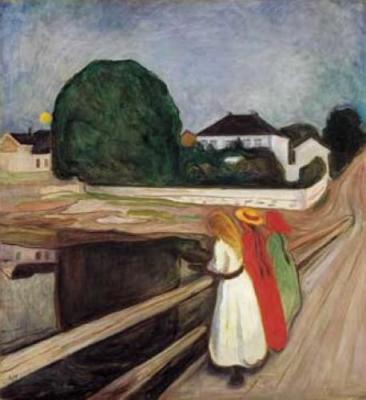
|
Astroseti.org : El Universo a tu alcance Astronomía, Astrobiología, Astrofísica, Astronáutica, SETI y Ciencia en general. |
Te queda mucho por verAstroseti es mucho más que un simple portal de noticias.Por ejemplo traducimos artículos del Instituto de Astrobiología de la NASA (NAI), que estudia las condiciones para la existencia de vida fuera de nuestro planeta |
 ¿Problemas con la columna de noticias?
¿Problemas con la columna de noticias?Pulse aquí para eliminar columna de noticias |
|
Enviado por : Emilio González 2004-01-08 00:00:00 Scientists discover optical effect in a Munch’s landscape painting
The absence of reflection in the water represented in the picture of the Norwegian painter Edward Munch 'Girls on the pier' it is due to an optical effect and, therefore, it does not have a symbolic premeditation like it has been thought up to now. March 23, 2006.  In an article that will be published in the May issue of the magazine 'Sky and Telescope' the professors of the University of Texas Don Olson and Russell Doescher detail that the yellowish light that can be appreciated in the sky represented in the picture does not reflect in the water because the author was over the level of the sea. In an article that will be published in the May issue of the magazine 'Sky and Telescope' the professors of the University of Texas Don Olson and Russell Doescher detail that the yellowish light that can be appreciated in the sky represented in the picture does not reflect in the water because the author was over the level of the sea.
For this motive, they say, an asymmetry takes place in the reflection of the sky in the water of the fiord close to the port, which is captured with accuracy by Munch. For years, several experts have explained this absence of reflection as a license of the artist who was expressing his emotional situation. Nevertheless, these experts have come to the investigations of Marcel Minnaert, pioneer in optical atmospheric phenomena, who gives an explanation of what happens when someone sees an object reflected in the water over the level of the sea. Applying Minnaert's theory, these experts determined that Munch painted the picture from a point placed eleven feet over the level of the water, which allowed him to see the yellowish light of the sky directly, but not to estimate his reflection, which was covered by a nearby house. 'Girls on the pier' was inspired in the Asgardstrand's landscape (Norway), a place of vacations located in the south of the Artic Polar Circle, where Munch passed long seasons. These investigators travelled to the Norwegian locality, where they did topographic calculations and compared the points of escape of the picture with ancient photos of the port. In this way, they verified also that the object that emits the yellowish light was the moon and not the Sun, which up to the moment was a mystery due to the fact that Asgardstrand is in the summer solstice, where you can find a continuous luminous night in which both celestial bodies coexist. After verifying the route of the Sun and the Moon in the Norwegian sky, these investigators estimated that, while the solar twilight was far from the sight of the artist when he painted the picture, the Moon was just in the point from which the light is emitted. This team had already used another one picture from Munch 'The Shout' to reflect the effect that the explosion of the volcano Krakatoa had, at the end of the 19th century, in the colour of the sky, which appears reflected in the work of the Norwegian painter with intense reddish tones. Translated by Miguel Artime Enlace: |
Todavía no ha opinado nadie
Añadir Comentario
| |||||||

Visitas únicas desde 1/11/2005
Noticias 
|
15-May-2006 17:30 CET
Beber vino tinto podría ayudar a prevenir la sorderaUn reciente estudio indica que los antioxidantes presentes en el vino tinto, el te verde, y la aspirina, combaten a los radicales libres responsables de ciertos tipos de sordera. Enviado por :Michael Artime Comentarios : 5 |
|
15-May-2006 13:37 CET
Un ratón resistente al cáncerTres centros de investigación aliados para descubrir el secreto de este extraordinario roedor. Enviado por :Fernando Muñoz Sagasta Comentarios : 4 |
|
15-May-2006 12:55 CET
XMM-Newton pone al desnudo a las nebulosas galácticasLa inigualada precisión de sus mediciones debería permitir a los astrónomos una mejor comprensión del origen de los elementos químicos que pueblan el cosmos. Enviado por :Fernando Muñoz Sagasta |
|
15-May-2006 10:20 CET
Japón pulveriza el record de duración de plasmaDesde el país del sol naciente, la Agencia de Energía Atómica Nipona informa que su reactor experimental tokamak (llamado JT-60) ha conseguido casi duplicar el anterior record de duración de sustentación del plasma. Enviado por :Michael Artime Comentarios : 2 |
|
15-May-2006 10:07 CET
Xena: el enigma del décimo planeta del sistema solarLas recientes mediciones efectuadas por el telescopio espacial Hubble han permitido avanzar en la resolución del enigma del décimo planeta del sistema solar, llamado Xena, el cual es un poco mayor que Plutón. Enviado por :Fernando Muñoz Sagasta Comentarios : 2 |
|
15-May-2006 01:25 CET
Siga a ese NitrógenoDos astrobiólogos de la Universidad de Carolina del Sur reclaman que se busque nitrógeno, y no solo agua, a la hora de detectar evidencias de vida, presente o pasada, en otros mundos. Enviado por :Michael Artime |
| Más noticias |
Astroseti es una asociación sin ánimo de lucro formada por voluntarios que dedican su tiempo libre a la traducción de artículos con fines divulgativos.
Esta permitida la utilización de parte del contenido de nuestros artículos en otras páginas web siempre que se incluya enlace a la dirección original en Astroseti. Si desea utilizar el texto completo de uno de nuestros contenidos deberá solicitar autorización.